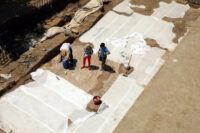 A large 4th century mosaic discovered in Gaziantep, southern Turkey, in 2019 when looting activity was reported at a private home has been removed in 98 pieces and transported to the Zeugma Mosaic Museum. The illegal excavation was reported in time to save a massive mosaic covering 1830 square feet, the entire courtyard of the property. It took two days to raise and transport every section of the mosaic to the museum.
A large 4th century mosaic discovered in Gaziantep, southern Turkey, in 2019 when looting activity was reported at a private home has been removed in 98 pieces and transported to the Zeugma Mosaic Museum. The illegal excavation was reported in time to save a massive mosaic covering 1830 square feet, the entire courtyard of the property. It took two days to raise and transport every section of the mosaic to the museum.
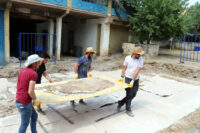 The house was secured by the Provincial Directorate of Culture and Tourism and salvage efforts began in 2020. A thorough excavation revealed mosaics composed of white and multi-colored stone and glass tesserae. Panels depicting figures — a kneeling man carrying a sword, a goddess wearing a diadem, carrying a spear and holding the leash of a wild beast — and animals are bordered by geometric designs.
The house was secured by the Provincial Directorate of Culture and Tourism and salvage efforts began in 2020. A thorough excavation revealed mosaics composed of white and multi-colored stone and glass tesserae. Panels depicting figures — a kneeling man carrying a sword, a goddess wearing a diadem, carrying a spear and holding the leash of a wild beast — and animals are bordered by geometric designs.
Ayşe Ebru Çorbacı, deputy director of the Gaziantep Museum, who also worked as a restorer in the rescue excavations, said that they could not remove the mosaic as a whole and that they divided it into pieces.
“When we started the work, we detected some deterioration. We did cleaning works and documentation. During the cleaning phase, there was a layer that covered the figures, which challenged us the most. Then we started working to remove it. We protected it by covering a cloth. Unfortunately, we cannot remove it as a whole during the removal phase as there are many different patterns and figures on it. Both the conditions and the structure of the mosaic do not allow it. So we had to divide it into pieces. We made these divisions by considering the figures. We will remove the figures as they are, with no damage. Then we will work on combining them,” she said.
It will now join august company in the largest mosaic museum in the world which contains 18,000 square feet of mosaics. This one mosaic increases that figure by 10%. You can visit the museum virtually here. It’s a bit clunky to navigate and the information panels aren’t translated, but it gives a glimpse into the vast space and exceptional collection of the Zeugma Mosaic Museum.
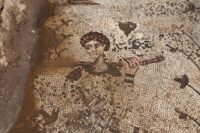
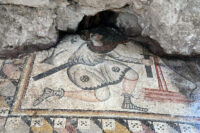
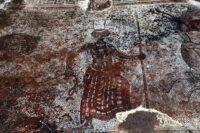
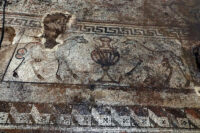
That kneeling youth is not only “carrying” a sword, but –judging by all that blood– thrusting it into somebody or something.
The Euphrates River Birecik Dam was built on top of the ruins of the ancient city of Zeugma, with a flooded lake surface of 56.25 km^2 and a capacity of 1220 Mio m^3 of water.
So to speak, a clear case of “more or less troubled water over bridge” (Ζεύγμα).